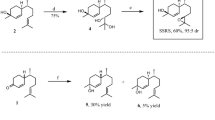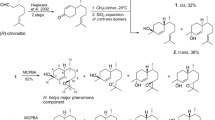Abstract
Harlequin bug (Murgantia histrionica) is an important pest of cole crops in the USA. The adults and nymphs feed on aboveground plant tissues by sucking cell contents and can seriously damage the host. Current insect control measures on cole crops target mainly lepidopteran pests, and the insecticides generally used do not control harlequin bug, so alternative management practices need to be explored. Previous research has established the existence of a male-produced pheromone attractive to both sexes and nymphs of M. histrionica. In this work, two systems of marking bugs were tested to verify if the mark affected fitness traits such as survival and host location. In a second phase, marked individuals were placed on trap host plants baited with synthetic pheromone lures to test whether migration rates were related to M. histrionica density on the trap plants and the presence of the attractants. Neither marking system affected the survival or orientation of the subjects compared to unmarked individuals. The pheromone lures significantly increased the attractiveness of the trap plants, but did not increase the retention time of the plants compared to unbaited plants. Emigration from the trap plants showed a constant rate and seemed unrelated to bug density on the plants. However, a mean peak density of ca. 36 bugs/plant was calculated. Beyond this number, density tended to decrease. These successful marking methods and retention time models support development of M. histrionica management with trap crops, by providing tentative control thresholds and decision rules.




Similar content being viewed by others
References
Aliabadi A, Renwick JA, Whitman DW (2002) Sequestration of glucosinolates by harlequin bug Murgantia histrionica. J Chem Ecol 28:1749–1762
Carey JR (1993) Applied demography for biologists with special emphasis on insects. Oxford University Press, New York, pp 10–11
Everitt BS (2002) The Cambridge dictionary of statistics, 2nd edn. Cambridge University Press, Cambridge, p 163
Fahey JW, Zalcmann AT, Talalay P (2001) The chemical diversity and distribution of glucosinolates and isothiocyanates among plants. Phytochemistry 56:5–51
Galizia CG (2014) Olfactory coding in the insect brain: data and conjectures. Eur J Neurosci 39:1784–1795
Hagiwara H, Okabe T, Ono H, Kamat VP, Hoshi T, Suzuki T, Ando MJ (2002) Total synthesis of bisabolane sesquiterpenoids, α-bisabol-1-one, curcumene, curcuphenol and elvirol: utility of catalytic enamine reaction in cyclohexenone synthesis. Chem Soc Perkin Trans 1:895–900
Hokkanen HMT (1991) Trap cropping in pest management. Annu Rev Entomol 36:119–138
Holden MH, Ellner SP, Lee DH, Nyrop JP, Sanderson JP (2012) Designing an effective trap cropping strategy: the effects of attraction, retention and plant spatial distribution. J Appl Ecol 49:715–722
Khrimian A, Shearer PW, Zhang A, Hamilton GC, Aldrich JR (2008) Field trapping of the invasive brown marmorated stink bug, Halyomorpha halys, with geometric isomers of methyl 2,4,6-decatrienoate. J Agr Food Chem 56:197–203
Khrimian A, Shirali S, Vermillion KE, Siegler MA, Guzman F, Chauhan K, Aldrich JR, Weber DC (2014) Stereochemical determination of the aggregation pheromone of harlequin bug, Murgantia histrionica (Hemiptera: Pentatomidae). J Chem Ecol 40:1260–1268
Ludwig SW, Kok LT (2001) Harlequin bug, Murgantia histrionica (Hahn) (Heteroptera: Pentatomidae) development on three crucifers and feeding damage on broccoli. Crop Prot 20:247–251
Midega CAO, Khan ZR, Pickett JA, Nylin S (2010) Host plant selection behaviour of Chilo partellus and its implication for effectiveness of a trap crop. Entomol Exp Appl 138:40–47
Peiffer M, Felton GW (2014) Insights into the saliva of the brown marmorated stink bug Halyomorpha halys (Hemiptera: Pentatomidae). PLoS ONE 9(2):e88483. doi:10.1371/journal.pone.0088483
Pettersson J, Karunaratne S, Ahmed E, Kumar V (1998) The cowpea aphid, Aphis craccivora, host plant odours and pheromones. Entomol Exp Appl 88:177–184
Schlyter F (1992) Sampling range, attraction range, and effective attraction radius: Estimates of trap efficiency and communication distance in coleopteran pheromone and host attractant systems. J Appl Entomol 114:439–454
Schowalter TD (2011) Insect ecology: an ecosystem approach. Academic Press, London, pp 175–178
Smith BH, Getz WM (1994) Nonpheromonal olfactory processing in insects. Annu Rev Entomol 39:351–375
SYSTAT Software, Inc. (2004) SYSTAT 11. Richmond, CA
VassarStats: Website for statistical computation (2014) http://vassarstats.net. Accessed 29 July 2014
Walgenbach JF, Schoof SC (2005) Insect control on cabbage, 2004. Arthropod Manag Tests 30:E14
Wall C, Perry JN (1987) Range of attraction of moth sex-attractant sources. Entomol Exp Appl 44:5–14
Wallingford AK, Kuhar TP, Schultz PB, Freeman JH (2011) Harlequin bug biology and pest management in brassicaceous crops. J Integr Pest Manag 2:H1–H4
Wallingford AK, Kuhar TP, Schultz PB (2012) Toxicity and field efficacy of four neonicotinoids on harlequin bug (Hemiptera: Pentatomidae). Fla Entomol 95:1123–1126
Wallingford AK, Kuhar TP, Pfeiffer DG, Tholl DB, Freeman JH, Doughty HB, Schultz PB (2013) Host plant preference of harlequin bug (Hemiptera: Pentatomidae), and evaluation of a trap cropping strategy for its control in collard. J Econ Entomol 106:283–288
Weber DC, Cabrera Walsh G, DiMeglio AS, Athanas MM, Leskey TC, Khrimian A (2014) Attractiveness of harlequin bug, Murgantia histrionica (Hemiptera: Pentatomidae), aggregation pheromone: Field response to isomers, ratios and dose. J Chem Ecol 40:1251–1259
Yamanka T, Teshiba M, Tuda M, Tsutsumi T (2011) Possible use of synthetic aggregation pheromones to control Plautia stali in kaki persimmon orchards. Agric For Entomol 13:321–331
Zahn DK, Moreira JA, Millar JG (2008) Identification, synthesis, and bioassay of a male-specific aggregation pheromone from the harlequin bug, Murgantia histrionica. J Chem Ecol 34:238–251
Zahn DK, Moreira JA, Millar JG (2012) Erratum to: Identification, synthesis, and bioassay of a male-specific aggregation pheromone from the harlequin bug, Murgantia histrionica. J Chem Ecol 38:126
Acknowledgments
The authors wish to acknowledge the help of the farm crew at the Beltsville Agricultural Research Center (BARC) in preparing the crops and plowed land used in these experiments, Mike Athanas for supplying the marking material and laboratory help, and Megan Herlihy for assistance in the laboratory.
Author information
Authors and Affiliations
Corresponding author
Additional information
Communicated by M. Traugott.
Rights and permissions
About this article
Cite this article
Walsh, G.C., Dimeglio, A.S., Khrimian, A. et al. Marking and retention of harlequin bug, Murgantia histrionica (Hahn) (Hemiptera: Pentatomidae), on pheromone-baited and unbaited plants. J Pest Sci 89, 21–29 (2016). https://doi.org/10.1007/s10340-015-0663-1
Received:
Revised:
Accepted:
Published:
Issue Date:
DOI: https://doi.org/10.1007/s10340-015-0663-1




